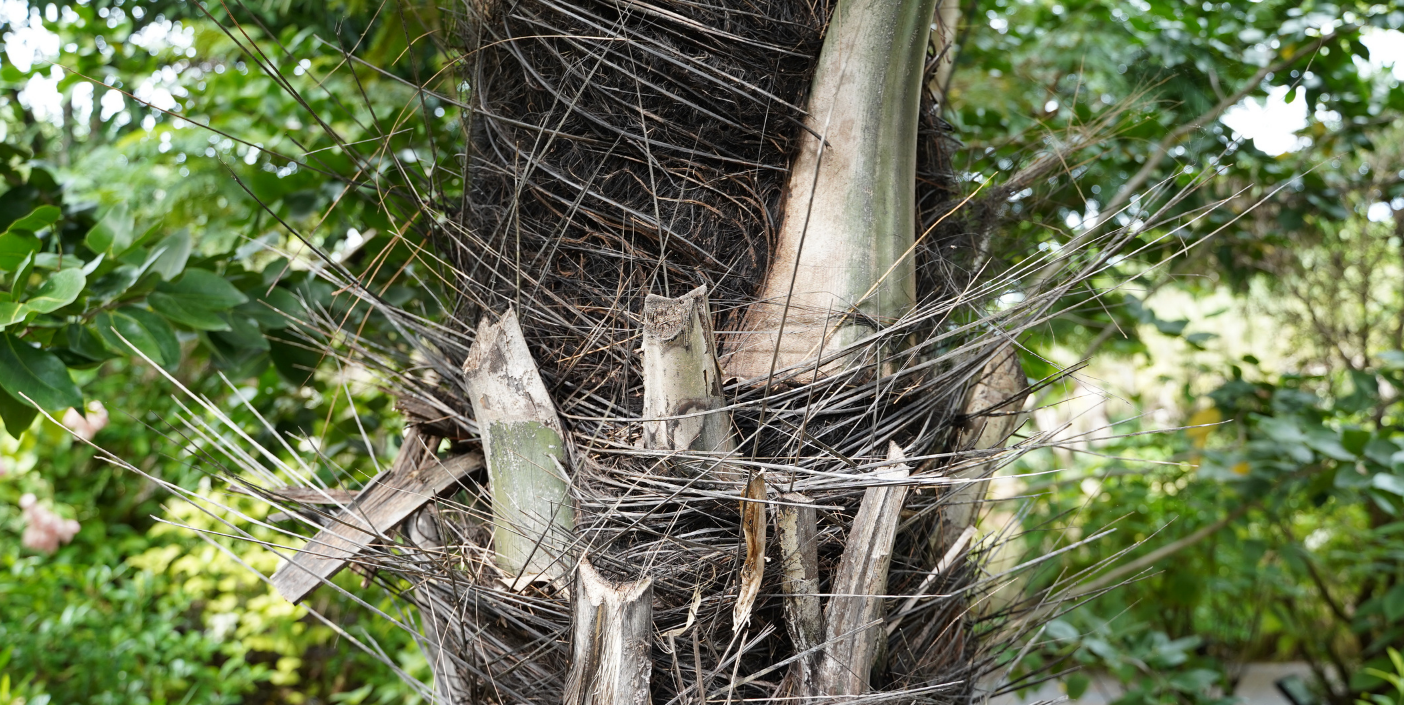
Monsters can come in all shapes and sizes, even in plant form. Take a stroll through the Garden, and see if you can find all these spooky plants lurking in the corners. Dare to discover them? That’s up to you!
Smith Entry Prow

Your spooky stroll through the Garden begins south of the Smith Entry Prow, where you will be greeted by a fruit that resembles a medieval mace or a grenade. This spiky fruit comes from the screw pine (Pandanus utilis), a small tree native to Madagascar. Its roots look like stilts and appear as though the tree could stand up and walk toward you with its fruit hanging from its thick crown.

Directly next to the screw pine is the Anthurium ‘Water Dragon,’ which has large waxy leaves with a black underside and a black spadix resembling a dragon or snake rising up from the plant.

Keep your eyes wide open on this Halloween hunt. Directly to the left of the Anthurium ‘Water Dragon’ is the zombie palm (Zombia antillarum). This palm is native to the island of Hispañola, comprising the Dominican Republic and Haiti. The zombie palm is heavily covered with long spines that spiral downward. These sharp spines were supposedly used as voodoo needles on the island.
LaGrippe Orchid Garden

Next, we head into the LaGrippe Orchid Garden, where darkness comes alive in plant form. Underneath all the bright and colorful orchids lies creepy black foliage, such as the Geogenanthus ciliatus along the Orchid Garden boardwalk. Native to Ecuador and Peru, this is a rare flowering plant from the dayflower and spiderwort family that has waxy, round leaves in a purple color so dark that it appears black.

As you enter the garden, you’ll find the Osmoxylon lineare, commonly known as the green aralia, on your left. Native to the Philippines, the flower of this shrub resembles a blackened, rotten brain.

You can spot more black foliage by the reflection pond, where you’ll find the Begonia ‘Joe Hayden.’ Its dark green star-shaped leaves appear dark purple and black and have a burgundy underside. Its leaves create an ornamental aesthetic fit for a zombie bride.
Water Garden

Leave the Orchid Garden, and head to the Water Garden to see where darkness swims amongst the water. Colocasia esculenta ‘Black Magic,’ located near the base of the great blue heron statue, is a plant with heart-shaped, deep purple leaves. Native to the Philippines, this plant can grow to 6 feet tall and wide with its cluster of leaves. This plant appears like a grouping of black butterflies about to swarm you.

Across the boardwalk from C. esculenta ‘Black Magic’ is Colocasia esculenta ‘Black Coral,’ native to Eastern Asia. This elephant ear plant has large and glossy dark leaves that add drama and will stop you in your tracks with their beautiful ornamental look.
Marcia and L. Bates Lea Asian Garden

Make your way toward the Lea Asian Garden, where you will be greeted by various ancient temple ruins. Head toward the right of the path, and you will spot the sugar palm (Argenga westerhoutii), a sweet-sounding tree that is anything but. Its trunk is encased in needles that make it look like a medieval torture chamber. Imagine, what if you had a forest filled with this palm, and you had to walk through it without running into any sharp needles? If this plant weren’t creepy enough already, here’s another fact: Once it blooms, it dies.

Walk behind the pathway to the Shrine of Dewi Sri, Goddess of Rice and Fertility, toward the palmyra palm (Borassus flabellifer), to view a black palm tree with spiky branches. Native to Asia, this tree can grow up to 98 feet and live up to 100 years.

Weave your way to the back of the Lea Asian Garden near the reflection ponds and beautiful murals, and descend upon the black bat flower (Tacca chantrieri). This plant has dark purple wing-like bracts above its cluster of purple flowers; the bracteoles that hang from the flowers resemble whiskers. This plant is also known as the devil’s flower and cat’s whiskers.
Kathleen and Scott Kapnick Brazilian Garden

Native to India and Malaysia, the purple-hued foliage called dragon’s tongue (Hemigraphis repanda), located near the Performance Lawn, is a creepy crawler that resembles a dragon’s forked tongue.

Near the beautiful silk floss tree along the curved path, you will find the bloodwood tree (Pterocarpus officinalis), which is named for its dark red sap. If its trunk is pierced, it will begin to drip sticky, reddish-brown fluid that will help to seal the tree’s wound.
Irma’s Garden

As you make your way from the Kapnick Brazilian Garden, head toward Irma’s Garden by the Berger Shop in the Garden, and view the midnight horror tree (Oroxylum indicum). This plant is also known as the “broken bones plant” because its branches look like broken limb bones. These will fall off the tree when its leaves wither and pile up, appearing as a boneyard.
This lanky and sparse tree is often grown as an ornamental for its strange appearance. It earned its name because it is a night bloomer and has flowers that emit a strong, malodorous odor, which attracts bats. It also has seed pods that look like swords hanging from the tree.
There you have it, some (or most of) these spooky plants will make your skin crawl, and some will give you fun ideas for Halloween foliage!

About the Author
Darby Kordonowy is the Content Coordinator for Naples Botanical Garden. Darby loves learning! Her favorite plants are the jade vine (Strongylodon macrobotrys) and the Camellia japonica ‘Pink Perfection.’ She is an amateur bird watcher!

